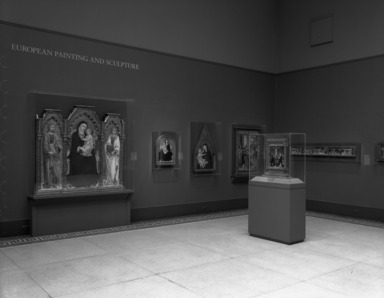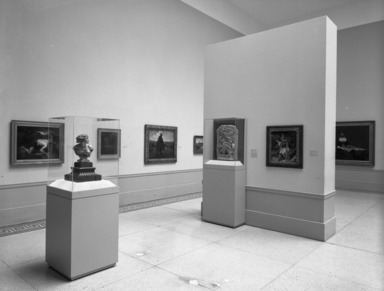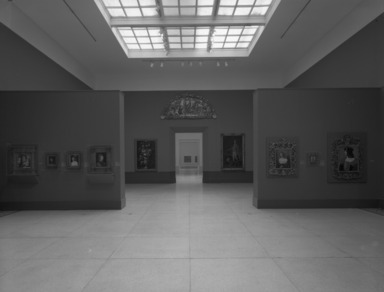

European Painting and Sculpture (installation), January 01, 1995 through 1996 (date unknown) (Image: PHO_E1995i048.jpg Brooklyn Museum photograph, 1995)
European Painting and Sculpture (installation)
DATES January 01, 1995 through 1996 (date unknown)
ORGANIZING DEPARTMENT
European Painting and Sculpture
COLLECTIONS
European Art
-
August 1, 1996
More than 125 European paintings and sculptures from the collection of The Brooklyn Museum will be reinstalled in refurbished galleries, which will open to the public Friday, October 11, 1996, following a year and a half roof repair project. Sarah Faunce, Curator, and Elizabeth Easton, Associate Curator, European Painting and Sculpture, The Brooklyn Museum, have organized the reinstallation, which traces the course of painting in Europe from the 14th through the early 20th century, with emphasis on the early Renaissance in Italy and 19th-century France.
Featured in the reinstallation will be three Italian Renaissance paintings on view for the first time in more than sixty years. These newly conserved works are Scene from the Story of Nastagio Degli Onesti (after 1483), from the workshop of Davide Ghirlandaio; Andrea di Bartolo’s triptych Madonna of Humility (before 1428); and Madonna and Child with Angels (circa mid-1520s), from the workshop of Bernardo Luini. Also on view is a very important small altarpiece by Maso di Banco and Madonna and Child Enthroned with Saints Zenobius, John the Baptist, Reparata, and John the Evangelist (circa. 1355) by Nardo di Cione, acquired last year from The New-York Historical Society.
Paintings by such artists as Francisco de Goya, Frans Hals, and Giovanni Paolo Panini highlight the artistic achievements of the 16th, 17th, and 18th centuries in Western Europe. Among the 19th-century French paintings featured in the reinstallation are Study for the Wounded Cuirassier (1814) by Jean Louis Andre Theodore Gericault, Edgar Degas’s Mlle. Fiocre in the Ballet “La Source” (circa 1866), the first painting for which the artist took the ballet as his subject; Giovanni Boldini’s 1897 portrait of James A. McNeilI Whistler; five canvases by Claude Monet; and works by Gustave Caillebotte, Paul Cézanne, Eugène Delacroix, and Camille Pissarro, among others.
The reopening of the European galleries will coincide with the exhibition In the Light of Italy: Corot and Early Open-Air Painting, opening at the Museum on October 11 as well. It comprises 130 paintings by 48 artists from a number of European countries who worked in the Italian landscape between 1780 and 1840. The exhibiton will be complemented by an installation in the European galleries, drawn from the Museum’s growing collection of 19th-century open-air sketches by such artists as François-Auguste Bonheur, Charles-François Daubigny, Pierre Thuillier, and Constantin [sic] Troyon, among others.
The revolutionary changes in Western art that began during the first decades of the 20th century are reflected in paintings by such artists as Georges Braque, Andre Derain, Vasily Kandinsky, and Kees van Dongen. The results of this artistic revolution are on view in the Museum’s galleries of post-war and contemporary art.
Brooklyn Museum Archives. Records of the Department of Public Information. Press releases, 1995 - 2003. 07-12/1996, 101-102.
View Original -
October 11, 1996
More than 125 European paintings and sculpture from the collection of the Brooklyn Museum of Art have been reinstalled in refurbished galleries that opened to the public on October 11, 1996, following a year and a half roof repair project. Sarah Faunce, Curator, and Elizabeth Easton, Associate Curator, of European Painting and Sculpture at the Brooklyn Museum of Art, have organized the reinstallation, which traces the course of painting in Europe from the 14th through the early 20th century, with emphasis on the early Renaissance in Italy and 19th century France.
Featured in the reinstallation are three Italian Renaissance paintings on view for the first time in more than sixty years. Newly conserved, they are Scene from the Story of Nastagio Degli Onesti (after 1483), from the workshop of Davide Ghirlandio; Andrea di Bartolo’s triptych Madonna of Humility, the Redentor (before 1428); and Virgin and Child with Angels (c. mid-1520s), from the workshop of Bernardo Luini. Also on view is a very important small altarpiece by Maso di Banco and a portrait by Giovanni Bellini, as well as the recently acquired Madonna and Child Enthroned with Saints Zenobius, John the Baptist, Reparata, and John the Evangelist (c. 1355) by Nardo di Cione.
Paintings by such artists as Francisco de Goya, Frans Hals, and Giovanni Paolo Panini highlight the artistic achievements of the 16th, 17th, and 18th centuries in Western Europe. Among the 19th century French paintings featured in the reinstallation are Study for the Wounded Cuirassier (1814) by Jean Louis Andre Theodore Gericault, Edgar Degas’ Mlle. Fiocre in the Ballet “La Source” (c. 1866), the first painting for which the artist took the ballet as his subject; Giovanni Boldini’s 1897 portrait of James A. McNeill Whistler; five canvases by Claude Monet; and works by Gustave Caillebotte, Paul Cézanne, Eugène Delacroix, and Camille Pissarro, among others.
The revolutionary changes in Western art that began during the first decades of the 20th century are reflected in paintings by such artists as Georges Braque, Andre Derain, Vasily Kandinsky, and Kees van Dongen. The results of this artistic revolution are on view in the Museum’s galleries of post-war and contemporary art.
Brooklyn Museum Archives. Records of the Department of Public Information. Press releases, 1995 - 2003. 07-12/1996, 115-116.
View Original

